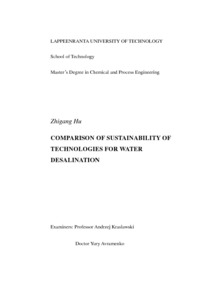Comparison of sustainability of technologies for water desalination
Hu, Zhigang (2014)
Diplomityö
Hu, Zhigang
2014
Julkaisun pysyvä osoite on
https://urn.fi/URN:NBN:fi-fe2014061629249
https://urn.fi/URN:NBN:fi-fe2014061629249
Tiivistelmä
The aim of this work is to perform an in-depth overview on the sustainability of several major commercialized technologies for water desalination and to identify the challenges and propose suggestions for the development of water desalination technologies. The overview of those technologies mainly focuses on the sustainability from the viewpoint of total capital investment, total product cost, energy consumption and global warming index. Additionally, a systematic sustainability assessment methodology has been introduced to validate the assessment process. Conclusions are:1) Reverse osmosis desalination (RO) plants are better than multi-stage flash distillation (MSF) desalination plants and multiple-effect distillation (MED) desalination plants from the viewpoint of energy consumption, global warming index and total production cost; 2)Though energy intensive, MSF plants and MED plants secure their advantages over RO plants by lower total capital investment, wider applicability and purer water desalted and they are still likely to flourish in energy-rich area;3) Water production stage and wastewater disposal stage are the two stages during which most pollutant gases are emitted. The water production stage alone contributes approximately 80~90% of the total pollutant gases emission during its life cycle; 4)The total capital cost per m3 desalted water decreases remarkably with the increasing of plant capacity. The differences between the capital cost per m3 desalted water of RO and other desalination plants will decrease as the capacity increases; 5) It is found that utilities costs serve as the major part of the total product cost, and they account for 91.16%, 85.55% and 71.26% of the total product cost for MSF, MED and RO plants, respectively; 6) The absolute superiority of given technology depends on the actual social-economic situation (energy prices, social policies, technology advancements).
